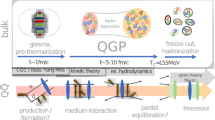Abstract
We compare numerical predictions of the conventional QCD parton model and of the k T-factorization approach (semihard theory) for heavy-quark production in high-energy hadron collisions. The total production cross sections and one-particle rapidity and p T distributions, as well as two-particle correlations, are considered. The distinction between the predictions of the two approaches is not very large, while the shapes of the distributions are slightly different.
Similar content being viewed by others
References
P. Nason, S. Dawson, and R. K. Ellis, Nucl. Phys. B 303, 607 (1988).
G. Altarelli et al., Nucl. Phys. B 308, 724 (1988).
P. Nason, S. Dawson, and R. K. Ellis, Nucl. Phys. B 327, 49 (1989).
W. Beenakker, H. Kuijf, W. L. van Neerven, and J. Smith, Phys. Rev. D 40, 54 (1989).
W. Beenakker, W. L. van Neerven, R. Meng, et al., Nucl. Phys. B 351, 507 (1991).
M. N. Mangano, P. Nason, and G. Ridolfi, Nucl. Phys. B 373, 295 (1992).
S. Frixione, M. N. Mangano, P. Nason, and G. Ridolfi, Preprint CERN-TH/97-16 (1997); hep-ph/9702287.
Yu. M. Shabelski, Talk given at HERA Monte Carlo Workshop, DESY, Hamburg, 1998; hep-ph/9904492.
S. Catani, M. Ciafaloni, and F. Hautmann, Phys. Lett. B 242, 97 (1990); Nucl. Phys. B 366, 135 (1991).
J. C. Collins and R. K. Ellis, Nucl. Phys. B 360, 3 (1991).
G. Marchesini and B. R. Webber, Nucl. Phys. B 386, 215 (1992).
S. Catani and F. Hautmann, Phys. Lett. B 315, 475 (1993); Nucl. Phys. B 427, 475 (1994).
S. Camici and M. Ciafaloni, Nucl. Phys. B 467, 25 (1996); Phys. Lett. B 396, 406 (1997).
L. V. Gribov, E. M. Levin, and M. G. Ryskin, Phys. Rep. 100, 1 (1983).
E. M. Levin and M. G. Ryskin, Phys. Rep. 189, 267 (1990).
E. M. Levin, M. G. Ryskin, Yu. M. Shabelski, and A. G. Shuvaev, Yad. Fiz. 53, 1059 (1991) [Sov. J. Nucl. Phys. 53, 657 (1991)].
E. M. Levin, M. G. Ryskin, Yu. M. Shabelski, and A. G. Shuvaev, Yad. Fiz. 54, 1420 (1991) [Sov. J. Nucl. Phys. 54, 867 (1991)].
M. G. Ryskin, Yu. M. Shabelski, and A. G. Shuvaev, Z. Phys. C 69, 269 (1996).
Yu. M. Shabelski and A. G. Shuvaev, Eur. Phys. J. C 6, 313 (1999).
M. G. Ryskin, Yu. M. Shabelski, and A. G. Shuvaev, Yad. Fiz. 64, 123 (2001) [Phys. At. Nucl. 64, 120 (2001)]
M. Gluck, E. Reya, and A. Vogt, Z. Phys. C 67, 433 (1995).
M. Gluck, E. Reya, and A. Vogt, Eur. Phys. J. C 5, 461 (1998).
J. C. Collins, D. E. Soper, and G. Sterman, Nucl. Phys. B 308, 833 (1988).
S. Narison, Phys. Lett. B 341, 73 (1994); hep-ph/9503234.
P. Ball, M. Beneke, and V. M. Braun, Phys. Rev. D 52, 3929 (1995).
J. Blümlein, Preprint 95-121, DESY (Hamburg, 1995).
E. A. Kuraev, L. N. Lipatov, and V. S. Fadin, Zh. Éksp. Teor. Fiz. 72, 377 (1977) [Sov. Phys. JETP 45, 199 (1977)].
G. Marchesini and B. R. Webber, Nucl. Phys. B 310, 461 (1988).
M. A. Kimber, A. D. Martin, and M. G. Ryskin, Eur. Phys. J. C 12, 655 (2000).
Yu. L. Dokshitzer, D. I. Dyakonov, and S. I. Troyan, Phys. Rep. 58, 270 (1980).
S. J. Brodsky, G. P. Lepage, and P. B. Mackenzie, Phys. Rev. D 28, 228 (1983).
G. P. Lepage, J. Comput. Phys. 27, 192 (1978).
J. Kwiechinski, Z. Phys. C 29, 561 (1985).
M. N. Mangano, P. Nason, and G. Ridolfi, Nucl. Phys. B 405, 507 (1993).
Liu Wenjie, O. P. Strogova, L. Cifarelli, and Yu. M. Shabelski, Yad. Fiz. 57, 900 (1994) [Phys. At. Nucl. 57, 844 (1994)].
Author information
Authors and Affiliations
Additional information
From Yadernaya Fizika, Vol. 64, No. 11, 2001, pp. 2080–2090.
Original English Text Copyright © 2001 by Ryskin, Shabelski, Shuvaev.
This article was submitted by the authors in English.
Rights and permissions
About this article
Cite this article
Ryskin, M.G., Shabelski, Y.M. & Shuvaev, A.G. Comparison of the k T-factorization approach and the QCD parton model for charm and beauty hadroproduction. Phys. Atom. Nuclei 64, 1995–2005 (2001). https://doi.org/10.1134/1.1423749
Received:
Accepted:
Issue Date:
DOI: https://doi.org/10.1134/1.1423749




